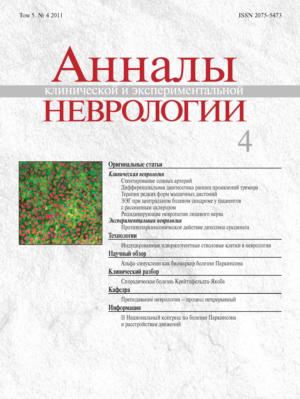Противопаркинсоническое действие дихолина сукцината на модели МФТП-индуцированного паркинсонизма
- Авторы: Сариев A.K.1, Рычихин В.M.1, Помыткин И.A.2, Воронина T.A.3
-
Учреждения:
- Научный центр неврологии РАМН
- ООО «Биосигнал»
- НИИ фармакологии им. В.В. Закусова
- Выпуск: Том 5, № 4 (2011)
- Страницы: 33-36
- Раздел: Оригинальные статьи
- Дата подачи: 03.02.2017
- Дата публикации: 13.02.2017
- URL: https://annaly-nevrologii.com/journal/pathID/article/view/290
- DOI: https://doi.org/10.17816/psaic290
- ID: 290
Цитировать
Полный текст
Аннотация
Изучено противопаркинсоническое действие дихолина сукцината при интраназальном введении в дозах от 0,2 до 5,0 мг/кг на модели паркинсонизма, индуцированного у мышей линии C57B1/6 однократной внутрибрюшинной инъекцией 25 мг/кг 1-метил-4-фенил-1,2,3,6-тетрагидропиридина (МФТП). Выявлено, что дихолина сукцинат обладает достоверным противопаркинсоническим эффектом, который выражается в уменьшении проявлений акинезии по показателям горизонтальной двигательной активности в тесте «открытого поля» (в дозах 0,2, 1,0 и 5 мг/кг) и мышечной ригидности по показателю длины шага животного (в дозах 1 и 5 мг/кг). Вместе с тем дихолина сукцинат не устраняет такие проявления основной симптоматики паркинсонического синдрома, вызванного МФТП, как тремор, пилоэрекция, латеро- и ретропульсия.
Об авторах
A. K. Сариев
Научный центр неврологии РАМН
Email: platonova@neurology.ru
Россия, Москва
В. M. Рычихин
Научный центр неврологии РАМН
Email: platonova@neurology.ru
Россия, Москва
И. A. Помыткин
ООО «Биосигнал»
Email: platonova@neurology.ru
Россия, Москва
T. A. Воронина
НИИ фармакологии им. В.В. Закусова
Автор, ответственный за переписку.
Email: platonova@neurology.ru
Россия, Москва
Список литературы
- Воронина Т.А., Вальдман Е.А., Неробкова Л.Н. Методические указания по изучению антипаркинсонической активности фармакологических веществ, Руководство по экспериментальному (доклиническому) изучению новых фармакологических веществ. М., 2005: 295–307.
- Gerlach M., Riederer P. Animal models of Parkinson’s sdisease: An empirical comparison with the phenomenology of the disease in man. J. Neural Transm. 1996; 103: 987–1041.
- German D.C., Nelson E.L., Liang С.L. et al. The neurotoxin MPTP causes degeneration of specific nucleus A8, A9 and A10 dopaminergic neurons in the mouse. Neurodegeneration 1996; 5: 299–312.
- Schapira A.H.V. Progress in neuroprotection in Parkinson’s disease. Eur. J. Neurol. 2008; 15 (Suppl. 1): 5–13.
- Schmidt N., Ferger B. Neurochemical findings in the MPTP model of Parkinson’s disease. J. Neural Transm. 2001; 108: 1263–1282.
- Storozheva Z.I., Proshin A.T., Sherstnev V.V. et al. Dicholine salt of succinic acid, a neuronal insulin sensitizer, ameliorates cognitive deficits in rodent models of normal aging, chronic cerebral hypoperfusion, and beta-amyloid peptide-(25-35)-induced amnesia. BMC Pharmacol. 2008; 8: 1.
- Storozhevykh T.P., Senilova Y.E., Persiyantseva N.A. et al. Mitochondrial respiratory chain is involved in insulin-stimulated hydrogen peroxide production and plays an integral role in insulin receptor autophosphorylation in neurons. BMC Neurosci. 2007; 8: 84.
Дополнительные файлы








